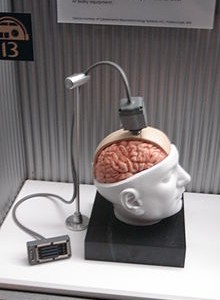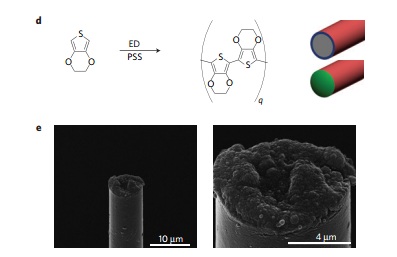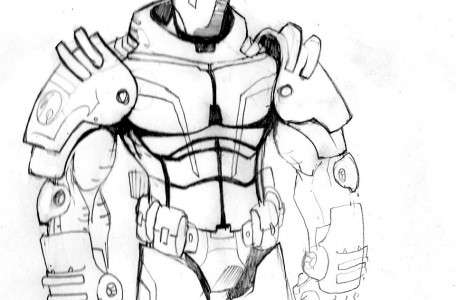Having explained the basic technology and historical significance of MMI, we now move to current applications of this visionary technology. While these new developments are based on important breakthroughs made by pre-War scientists, it was Minervan researchers who have made those discoveries into usable products.
In order to be complete, our continued discourse on Mind Machine Interfaces (MMI) must include at least some reference to the ideas, fantasies, and primitive applications of this technology invented in the late 20th and early 21st centuries, with special emphasis on their beliefs and perceptions on what was, at that time, a purely theoretical invention.
Related posts:
- Mind Machine Interfaces: Part 1 of 3 The concept and goal of an electrical/computational interface directly with the brain has long been Read more...
- Powered Armor - Part 2 of 3: 21st Century Tech Today’s continuation of our discussion of Powered Armor will focus around the existing technology in Read more...
- Singularity Thoughts part 5: Competing theories So, I’ve had some interesting thoughts while reading some of the singularity websites my friend Read more...
The concept and goal of an electrical/computational interface directly with the brain has long been the subject of scientific and fictional pursuit. These records date from the early 1970′s and some of the scientists involved formed part of the early founding group at Minerva:
In 1969 the operant conditioning studies of Fetz and colleagues, at the Regional Primate Research Center and Department of Physiology and Biophysics, University of Washington School of Medicine in Seattle, showed for the first time that monkeys could learn to control the deflection of a biofeedback meter arm with neural activity. Similar work in the 1970s established that monkeys could quickly learn to voluntarily control the firing rates of individual and multiple neurons in the primary motor cortex if they were rewarded for generating appropriate patterns of neural activity.
Studies that developed algorithms to reconstruct movements from motor cortex neurons, which control movement, date back to the 1970s. In the 1980s, Apostolos Georgopoulos at Johns Hopkins University found a mathematical relationship between the electrical responses of single motor cortex neurons in rhesus macaque monkeys and the direction in which they moved their arms (based on a cosine function). He also found that dispersed groups of neurons, in different areas of the monkey’s brains, collectively controlled motor commands. But he was able to record the firings of neurons in only one area at a time, because of the technical limitations imposed by his equipment.
Some of the issues that affected early researchers into this field are detailed in the archives recovered from Wikipedia and the science publications of the era. For example, as of November 2012 the following was published detailing current limitations while exposing their own novel innovations:
Today, most implantable neural microelectrodes trace back to the three historical microelectrode technologies: microwires; thin-film planar probes based on silicon or polymer substrates; or bulk micromachined arrays. Although incremental progress has been steady, there are still no definitive solutions for creating stable, long-lasting devices that elicit little or no deleterious tissue responses in the brain. As recent advances in the understanding of brain tissue responses come to the forefront of neural engineering , advances of these technologies are reaching limitations imposed by size, flexibility, strength, biocompatibility and electrical trade-offs of traditional materials such as metals, glass and silicon.
Ultrasmall implantable composite microelectrodes with bioactive surfaces for chronic neural interfaces - Takashi D. Yoshida Kozai
In that same publication the author details their novel innovation which resulted in an 8 micro meter diameter sheathed carbon fiber insert that is capable of reading signals from an individual neuron without prompting as heavy of an immune response nor as much neural damage upon insertion. This avenue of invasive measurements has long been stymied by the risks inherent in physically accessing and affecting the cells of the brain. To that end many alternatives had been explored which did not rely on physical connections or invasive procedures.
Scientists at the University of California, Berkeley, have reconstructed the internal “movie” that plays in a person’s head. To re-create dynamic visual experiences, they used functional magnetic resonance imaging (fMRI) to measure the brain activity of volunteers (the other members of the research team) as they watched short movie clips (left panel in the video below). A computational model crunched the fMRI data to reproduce the images, as shown in the right panel.
- http://en.wikipedia.org/wiki/Brain-computer_interface
The video below shows some examples of the type of clarity they could read from the visual cortex even in the year 2011. The hindrance to this mechanism was the requirement of a large medical apparatus and the requirement for the test subject to be relatively motionless and focused to avoid interference. In future exposes on this subject we will cover the medical and military uses envisioned by early 21st century, and finally we will cover the improvements that Minerva has achieved since the war, and their utilization in medicine and warfare by the Oracle project participants.
No related posts.
Many thanks to reader Jeremy Reiman, for sending us the link to this TED talk… truly a cool piece of work. I’ll let you watch the video first.
K… That was just awesome was it not. One important thing is that they are compiling a ridiculous amount of data to create that visualization. There was a lot of talk in the comments of that video about simulations versus visualization, and it is important to clarify that. Simulations are just make believe, they can be based on hypothesis yes, but there is no data behind it. Simulations can be computer rendered using the same technology as visualizations, but they are two different beasts. Visualizations can be prepared in many ways but are always based on actual data points. So in this case his camera can capture just ridiculous data points, and then they chug it through a potent computer to create these visualizations of the data.
It would be interesting to see how long of computer chugging time was required to produce the visualization, but one could postulate that with faster computers the processing time would of course diminish. How fast of a computer would we need to be able to record a video and then immediately begin playback? So things like this video, Lytro (https://www.lytro.com/) - which supposedly allows you to change your point of view after the picture was taken (by storing more information about the light as it hit the lens and re computing the image if you change position)… stinking amazying - are available in their infancy now.
In our story Jane has some pretty potent computing power in her matrix, and she is computing a battle field awareness that is based off of satellite’s the soldiers helmet cameras, microphones, sensors, and the images from the aerial observer drones… Is it that much of a stretch that she would be able to give them almost a real time battle field visualization? Or that she could then slow down and analyze the data for trajectories, patterns etc. You’ll see a lot more of this, and we will cover it again later in a science article, but we wanted to give a shout out to our reader.
Thanks for the contribution Jeremy, and thanks for reading!
No related posts.
In this third and final (for now) discussion on Minerva’s Powered Armor technology, we will focus on the technology in use on Project Oracle, as this is the most cutting edge fusion of Minerva’s technology into a combat initiative. Project Oracle is in early phases of beta testing, and a unit has been assigned to each Squad Captain The unit consists of many layers of cutting edge combat tech, and is controlled and maintained by an advanced Bio-Mechanical Artificial Intelligence. The concepts we will cover in this expose will be cleared through Oculus to make sure no sensitive information is exposed, but we propose to cover the following in sequence: Inner sensor and medical suit, scaffolding weight assist, muscular motive assist, sheathing and power, control, and armor/protection.
Related posts:
- Powered Armor - Part 2 of 3: 21st Century Tech Today’s continuation of our discussion of Powered Armor will focus around the existing technology in Read more...
- Powered Armor - Part 1 of 3: Overview Minerva has long held the advantage against the raider groups and paramilitary dictatorships that it Read more...
- Organically grown armor? Armor has obviously been important for warfare for basically forever. Making the best, most protective Read more...
- Final Relaunch Update - Nick has perfectionism issues
- Re-launch update 8-11-13
- Prelude to The War: The Middle Eastern Oil Crisis - Part 2
- Prelude to The War: The Middle Eastern Oil Crisis - Part 1
- Crossover Comic Dating Game: M9 Girls
- We got more fan art!
- Crossover Comic Dating Game: Rasputin Barxotka
- More fan art and opportunities for collaboration
- WIP World Map
- News, Webcomic Underdogs, and our First Fan Art!
Set in 22nd century Earth, over 100 years after the 3rd World War, the Demon Archives tells the survivors' stories as they struggle to rebuild civilization. In Book One, we'll meet the members of Minerva, one of the few high tech organizations that survived the War, and learn how they established a beacon of hope in the dreary wasteland of central Asia.
Minerva: Book One of the Demon Archives follows the story of Tenzin, a Minervan soldier, and his Oracle AI, Jane, as they fight to protect the ideals Minerva stands for in an increasingly chaotic world.
With a heavy basis in real science and technology with a healthy dallop of imagination, The Demon Archives will show you how life could be in a post-apocalyptic Earth.




